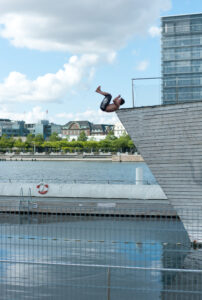What Copenhagen Gets Right About Public Space and Clean Water
I was in Copenhagen a few weeks ago. It was cold, like two jackets, scarf, beanie, hands shoved deep in my pockets kind of cold. I was walking along the harbor when I noticed a guy climbing out of the water in just swim trunks. Two other people were already dressed and drying off. They looked relaxed. Not shivering, not rushing. Just… done.
At first I thought they were doing some version of a polar plunge. But there were no crowds or events, just a few locals going for a swim like it was normal. And honestly, for them, it probably was.
What struck me wasn’t just that they were swimming in the middle of winter. It was that they were doing it right in the middle of the city. No one seemed concerned about the water being dirty or unsafe. There were ladders bolted into the edge, platforms to stand on, even a little sign marking the swim zone. It was all set up for people to use.

It made me wonder how that’s possible. Where I live, in Los Angeles, urban waterways are usually the opposite of inviting. They’re either full of trash, off-limits, or just treated like something we shouldn’t touch. But in Copenhagen, it felt like the harbor was part of the city in a real way, not just a view.
Later I looked into it. Back in the 80s and 90s, Copenhagen’s harbor wasn’t clean. There were issues with sewage overflows during storms and industrial pollution. The water definitely wasn’t swimmable. But instead of accepting that as the status quo, the city invested in fixing it. They upgraded the wastewater system, built underground reservoirs to hold runoff, and kept industrial waste out of the harbor. They also set up a system to monitor the water quality on a regular basis, not just in summer, but throughout the year.
This wasn’t a quick fix. It took years of planning and infrastructure work, but now the harbor is clean enough for people to swim in, even in winter. The city didn’t just hope the water would get better, it made sure of it.
That random moment, seeing two or three people quietly swimming while everyone else was bundled up, stuck with me. Not because it was dramatic, but because it felt totally matter-of-fact. This wasn’t a special event or a photo op. It was just people using public space in a way that most cities don’t allow for.
It made me think about what we accept as normal. Dirty urban water is seen as inevitable in a lot of places. But Copenhagen shows that it isn’t. If the water is polluted, it’s because no one’s prioritized making it clean. If people aren’t swimming, it’s because we haven’t designed our cities for that to be possible.
I didn’t go in the water that day. It was freezing, and I’m not built for that kind of cold. But I walked away thinking: more cities could be like this. And maybe they should.
Josh H
References:
DHI Group. (n.d.). Safe bathing water in the heart of Copenhagen Harbour. Retrieved from https://www.dhigroup.com/projects/safe-bathing-water-in-the-heart-of-copenhagen-harbour
Nordregio. (n.d.). Copenhagen Harbour Baths. Retrieved from https://nordregio.org/sustainable_cities/copenhagen-harbour-baths/
